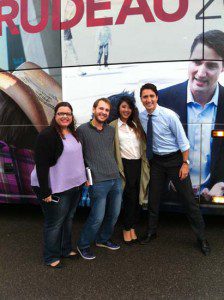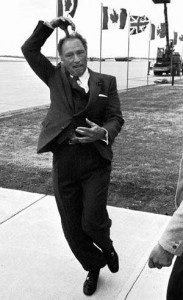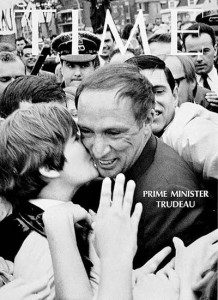 That morning, about three and a half weeks ago, this political candidate was on the firing line. Two CTV journalists had fashioned their feature interview with him based on some hard-hitting questions. Then, the TV journalists invited questions from those in the audience. Several of my journalism students, invited to the studio, got their chance to ask questions. And the politician answered them thoughtfully. Then, with the broadcast over, the politician headed for his tour bus to dash to his next event. As we were leaving the studio, my students passed by the candidate’s tour bus.
That morning, about three and a half weeks ago, this political candidate was on the firing line. Two CTV journalists had fashioned their feature interview with him based on some hard-hitting questions. Then, the TV journalists invited questions from those in the audience. Several of my journalism students, invited to the studio, got their chance to ask questions. And the politician answered them thoughtfully. Then, with the broadcast over, the politician headed for his tour bus to dash to his next event. As we were leaving the studio, my students passed by the candidate’s tour bus.
“Hold it there,” I said to my students, suggesting they pose in front of the logo on the bus. I raised my cell phone to snap the picture, when…
“Wait a second,” the young politician shouted from just outside camera range. “Let me join you,” and he jumped into the shot next to the student journalists and thanked them for being part of a political selfie.
The young man who hijacked my students’ photograph that morning outside CTV was Justin Trudeau, then Liberal leader and this week sworn in as the 23rd Prime Minister of Canada. Not surprisingly, already there’s buzz about the style of leader he will be and the style of government he will direct inside and outside the House of Commons.
If his arrival at the residence of Governor General David Johnston for the swearing-in ceremony, is any indication, it may be very different from anything either my journalism students (in their 20s) or I (not in my 20s) have ever seen. The fact that Trudeau and his 183 other elected Liberal MPs were delivered to Rideau Hall not in limos but by a bus was itself a departure. But for Justin Trudeau it may just be the first indicator of what some are calling his folksy style, as suggested by his spokeswoman Kate Purchase.
“It is sort of showing how much more open and transparent the new government intends to be,” she told the Ottawa Citizen.
Well, the Justin Trudeau government’s transparency will ultimately only be proven if he delivers on the wide array of election promises, if he invites the media back into less orchestrated scrums and policy announcements, if he replaces the muzzling of civil servants with freedom of expression, and if he chooses to lead the country by delegating authority to the cabinet ministers around him. Only time will tell if this prime minister allows his cabinet (for the first time made up of an equal number of women and men) to share the shaping of Canada over the next four years. Or, will he fall into the trap, that a British historian and moralist made famous in the 19th century.
“Power tends to corrupt and absolute power tends to corrupt absolutely,” John Acton said; then he added, “Great men are almost always bad men.”

Canadian political historians and the public have already passed judgement on Justin Trudeau’s father, Pierre Elliott Trudeau. Depending upon whom you meet – a disgruntled anti-NEP (National Energy Policy) believer, or a dyed-in-the-wool B&M (Bilingualism and Multiculturalism) advocate – Pierre Elliott Trudeau was either a tyrant or a saint. But there is no disputing his style. Even if one wasn’t around during his time at 24 Sussex, just about every formal photograph shows him wearing a rose and that toothy, impish smile, the one he flashed as he pirouetted behind Queen’s Elizabeth’s back following the repatriation of the Canadian constitution in 1980. But I distinctly remember a more distinct PET style.
Not long after Pierre Elliott Trudeau won the Liberal leadership in 1968, he called a federal election, seeking a mandate from a post-Lester Pearson Canada. And the response was not unlike that given his son last month; Trudeau the elder won 154 seats in his first majority. But it was the nature of the campaign that startled most of us. Sure, we had all witnessed crowd-pleasers such as the Beatles, but not in the nation’s political leaders. I remember Trudeau’s popularity reaching stratospheric levels that year.

There was one occasion in my riding of York-Scarborough, where the local candidate Bob Stanbury was running for re-election. As I recall, the rally took place outdoors in an open field. When word spread that Pierre Trudeau was joining Stanbury to help out, and suddenly the event took on greater importance. People seemed to arrive from everywhere. What had been an empty field minutes before, with myself and a number of other casual political observers, was suddenly transformed into a “happening.” When Trudeau arrived he was mobbed by people who just wanted to touch him. It seemed more like a religious or pop culture event. And I remember hearing what I had just witnessed described for the very first time.
“It’s Trudeau-mania,” somebody said.
The term stuck and so did Pierre Elliott’s style. Has history repeated itself? I don’t think so. The son has his father’s smile and surname, but a style all his own.
Great story Ted. I have had the experience of meeting
Prime Minister Pierre Trudeau during the repatriation
process of the Canadian Constitution Act 1867. Success
was Section 35 of the Canadian Constitution Act 1982.
Ekosi, Elmer